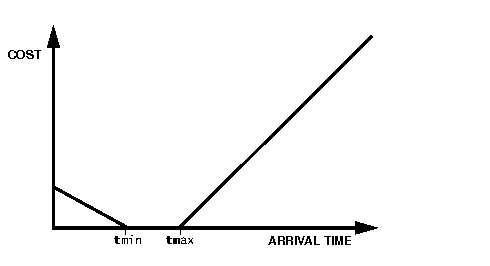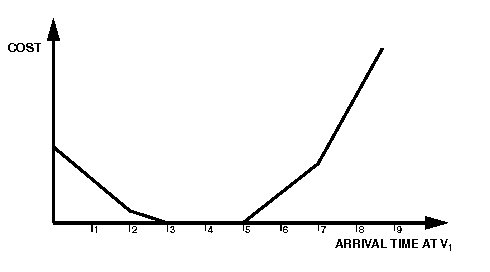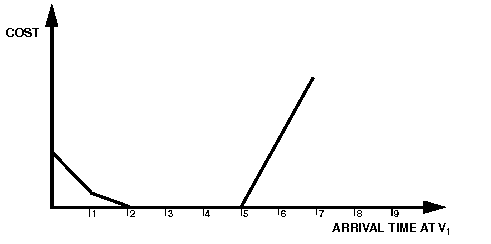Early and Late Cost Interdependence
 PREVIOUS
NEXT
PREVIOUS
NEXT
| IBM ILOG Dispatcher User's Manual > Transportation Industry Solutions > Adding Early and Late Costs > Describe > Early and Late Cost Interdependence |
Early and Late Cost Interdependence |
INDEX
 PREVIOUS
NEXT
PREVIOUS
NEXT
|
Figure 9.1 illustrates a cost-time relationship for a single delivery that has both early and late costs. Cost for an early delivery declines as it approaches the earliest desired arrival time (tmin), at which point cost is zero. After the latest desired arrival time (tmax), cost increases as time increases.

The relationship becomes more complex when you consider two visits, V1 and V2, such that V2 is directly after V1 on the route. Figure 9.2 depicts the cost function for these visits based upon arrival time at V1, where the time window for V1 is [2, 5]; the time window for V2 is [4, 8]; and the transit time from V1 to V2 is 1.

Under certain circumstances, a vehicle might need to wait between V1 and V2, causing an effective increase in the transit time. Figure 9.3 depicts the same two visits, V1 and V2, but with a transit time of 3.

This illustrates the importance of determining waiting times in order to identify optimal arrival times.
Step 1 - | Describe the problem |
The first step is to write a natural language description of the problem. A good way to start this process is to analyze the variables and objectives.
What are the constraints in this problem?
The objective is to minimize the cost of the delivery of all the parcels.
| © Copyright IBM Corp. 1987, 2009. Legal terms. | PREVIOUS NEXT |